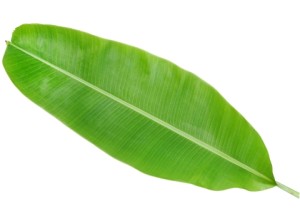Contents
Uses
- Banana leaves used in cuisine are generally large, flexible, and waterproof. When cooking food with or serving or wrapping food with banana leaves, they may confer an aroma to the food leaves; steaming with banana leaves imparts a subtle sweet flavour to the dish. The leaves are not themselves eaten and are discarded after the contents are consumed.The leaves contain the juices, protect food from burning and add a subtle flavor. In Tamil Nadu (India) leaves are fully dried and used as packing material for food stuffs and also making cups to hold liquid foods. The dried leaves are called ‘Vaazhai-ch- charugu’ (வாழைச் சருகு) in Tamil. Some South Indian, Filipino and Khmer recipes use banana leaves as a wrapper for frying. The leaves are later removed to retain flavor. In Vietnamese cuisine, banana leaves are used to wrap foods such as cha-lua.
Benefits
-
For Meals
The wrapped banana leaves that form the plant’s stem contain starch, which is extracted through a fermentation or cooking process. People in some parts of the world use the resulting flour for baking. The starch is also cooked into glue
-
For Healing
As a home remedy, banana-leaf poultices help to heal burns and other skin irritations, according to Purdue University, which adds that individuals suffering from, ulcers, diarrhea or dysentery may ingest the leaf ashes as a treatment for their condition. Check with your doctor before trying this approach.
-
For Cooking
According to an article on the website ReadersDigestVersion, banana leaves tenderize meat during the cooking process. The practice, common in Asian countries, is to wrap the food in the banana leaf and tie it with string before grilling, baking or steaming the dish. In some countries, people use banana leaves for lining cooking pits and for wrapping food, according to Purdue University. The banana foliage also becomes makeshift plates and placemats.
-
For Protection
People in South America and other areas of the world use banana leaves to block the rain and to provide protection from the hot sun, according to Purdue University
-
For the Garden and Beyond
Chopped up banana leaves, including the plant’s stem, serve as mulching material. Whole leaves protect other crops from the hot sun. People fold banana leaves into planters, use it as heavy-duty paper or use the fiber to make rope, string and baskets. Ecuadorians uses the leaves for seat cushions; West Africans makes fishing lines with the fiber. In the Philippines, people weave banana leaves into clothing; in Ceylon, they use the leaves to make the soles of shoes.
Cautions
- Ripe banana fruit does not have any serious side effects at moderate consumption.
- Ripe banana just like carrots contains carotene which may turn the palms and soles yellowish when consumed at large amount but this does not impose any health danger.
- The leaves and roots of Carica banana contain cyangenic glucosides which form into cyanide, while the leaves contain tannins. These two compounds may have adverse side effects when taken at large concentrations.
- Powdered banana when inhaled can induce allergies.
Interactions
- Please consult with your nutritionist or pharmacist.
Other names
n/a
References
Source: Wikipedia, https://en.wikipedia.org/wiki/Banana_leaf
Live Strong, http://www.livestrong.com/article/481033-what-are-the-benefits-of-banana-leaves/

